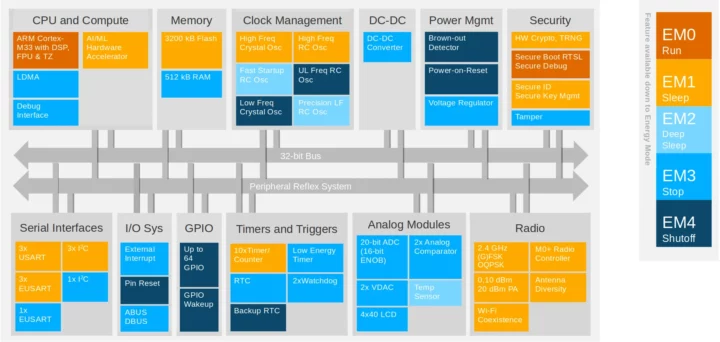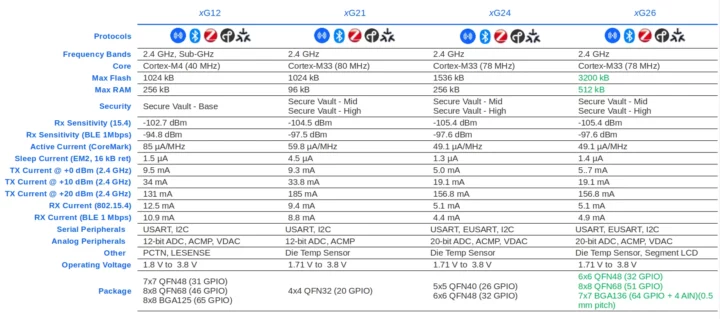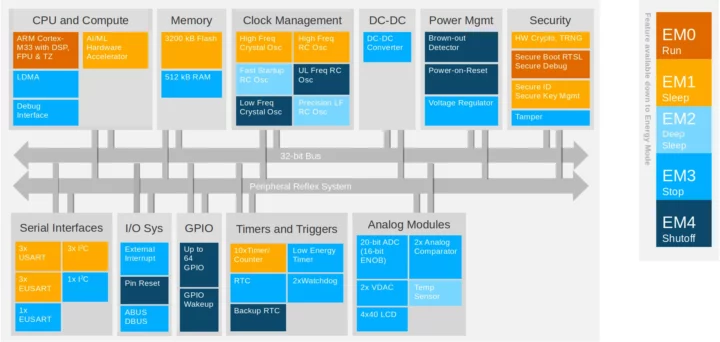Silicon Labs has announced the xG26 family of Cortex-M33 wireless SoCs and MCUs that consists of the multiprotocol MG26 SoC, the Bluetooth LE BG26 SoC, and the PG26 general-purpose MCU without wireless connectivity, and features double the flash and RAM of the Silicon Labs xG24 devices.
The xG26 family also comes with double the number of general-purpose input/output (GPIO) pins as the xG24 to enable engineers to build more complex devices in combination with the larger flash and memory reaching up to 3200 KB and 512KB respectively and also integrates a Matrix Vector Processor (MVP) for AI/ML hardware acceleration and Math functions.
Silicon Labs MG26 and BG26 wireless SoCs

MG26 and BG26 key features and specifications:
- MCU core – Arm Cortex-M33 @ 78 MHz
- AI/ML accelerator – Matrix Vector Processor that is 8x faster and 6x lower power than Cortex-M33 processing, and supports an MVP Math Library for non-ML workloads
- Memory – Up to 512 KB SRAM
- Storage – Up to 3,200 KB flash
- Wireless
- MG26 and BG26 – Bluetooth 5.3 (1M/2M/LR) and Bluetooth mesh
- MG26 only
- 802.15.4 radio for Zigbee, Thread, Matter over Thread
- 2.4 GHz proprietary
- Radio
- Up to +19.5 dBm TX
- -97.6 dBm RX @ BLE 1 Mbps
- -105.4 dBm RX @ 802.15.4
- Peripherals
- Display – 288 Segment LCD interface up to 4×40 or 8×36
- Communication – EUSART, USART, I2C
- Analog – 20-bit ADC with 6-bit ENOB, ACMP, VDAC
- Audio – I2S, PDM
- Up to 64x GPIOs
- Timers
- Security – Secure Vault Mid/High; Trustzone
- Misc – 500 PPM Precision Low Frequency RC Oscillator (LFRCO)
- Supply voltage – 1.71 to 3.8 Volts
- Power Consumption
- 5.7 mA TX @ 0 dBm
- 5.1 mA RX (802.15.4)
- 4.9 mA RX (BLE 1 Mbps)
- 1.4 µA EM2 sleep
- 33.4 µA/MHz
- Temperature Range – Up to +125ºC
- Packages
- 6×6 QFN48 (32x GPIO) – Drop-In Compatible with xG24 parts
- 8×8 QFN68 (51x GPIO)
- 7×7 BGA136 (64 GPIO + 4x AIN)

There’s no information about development boards for the BG26 and MG26 MCUs, but we do know some parts (QFN48) are pin-to-pin compatible with the equivalent xG24 parts, and the new Cortex-M33 microcontrollers are also programmable with Simplicity Studio 5. Machine Learning will be supported by Silicon Labs’ Machine Learning Toolkit with TensorFlow Lite, Edge Impulse and SensiML developers tools, and ML libraries will be made available by Sensory (wake word, voice command) and Micro.ai (anomaly detection).
Silicon Labs PG26 general-purpose microcontroller

PG26 specifications:
- MCU core – Arm Cortex-M33 @ 78 MHz
- AI/ML accelerator – Matrix Vector Processor that is 8x faster and 6x lower power than Cortex-M33 processing, and supports a MVP Math Library for non-ML workloads
- Memory – Up to 512 KB SRAM
- Storage – Up to 3,200 KB flash
- Peripherals
- Display – 288 Segment LCD interface up to 4×40 or 8×36
- Communication – EUSART, USART, I2C
- Analog – 20-bit ADC with 6-bit ENOB, ACMP, 12-bit VDAC
- Temperature sensor – +/- 1.5°C
- Up to 64x GPIOs
- Timers
- Security – Secure Vault Mid/High; Trustzone
- Misc – 500 PPM Precision Low Frequency RC Oscillator (LFRCO)
- Supply voltage – 1.71 to 3.8 Volts
- Power Consumption
- 33.4 µA/MHz (35 µA/MHz in the table below)
- 1.6 µA EM2 with 16 kB RAM
- 0.64 uA w/ RTC in EM4
- Temperature Range – -40 to +125ºC
- Packages
- 8×8 QFN68 (51 GPIO + 4 AIN)
- 7×7 BGA136 (64 GPIO + 4 AIN)
The PG26 is software compatible with the MG26 and BG26 wireless SoCs and mostly lacks wireless connectivity.
Silicon Labs xG26 use cases and target applications
The new MG26, BG26, and PG26 microcontrollers target a wide range of consumer and industrial applications as shown in the tables below for Home Automation, Home Security, smart appliances, entertainment devices, wearables, Smart Cities, industrial IoT, Smart Buildings, and Retail.
The MG26 multiprotocol SoC will be especially useful for Matter over Thread and enable better interoperability between IoT networks and ecosystems, the BG26 will be found in devices making use of Bluetooth LE and Mesh, and the PG26 should power unconnected applications like CCTV cameras, remotes, and children’s toys.
Silicon Labs did not provide availability information, and considering there aren’t any evaluation boards just yet and no mention of a demo at Embedded World 2024, it may take a while, maybe sometime in 2025, before mass production ramps up. More details may be found on the products page and in the press release.

Jean-Luc started CNX Software in 2010 as a part-time endeavor, before quitting his job as a software engineering manager, and starting to write daily news, and reviews full time later in 2011.
Support CNX Software! Donate via cryptocurrencies, become a Patron on Patreon, or purchase goods on Amazon or Aliexpress. We also use affiliate links in articles to earn commissions if you make a purchase after clicking on those links.



